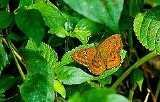
Coladenia dan
Encyclopedia
Pseudocoladenia dan, commonly known as the Fulvous Pied Flat, is a butterfly
belonging to the family Hesperiidae.
Recorded from Kumaon
(Doherty); Sikkim
(de Nicéville, Elwes); Cachar (Wood-Mason and de Nicéville); Kangra
, N.-W. Himalayas
(Moore); Nilgiris (Hampson).
Race andamanica:
"Specimens from Port Blair differ from continental ones in having the discal series of spots all run together so as to form an unbroken band, and the three subapical spots conjugated and in the same straight line, with their conjoined inner margin nearly straight and their outer festooned; and two examples exhibit in addition two smaller dots placed nearly parallel to the outer margin just below and external to the three subapical ones." (Wood-Mason and de Niceville in J. A. S. B., vol. I.)
Habitat: Andamans, Cachar.
In recording this variety from Cachar, Messrs. Wood-Mason and de Niceville note that specimens from that locality differ from Andaman specimens in the discal golden band of the upperside of the forewing being slightly broader, and the yellow spots on the underside of the hindwing obsolete; and that it agrees with P. dhanada, Moore, in the golden band not nearly reaching the anal angle of the forewing on the upperside (thereby differing from P. aurivittata, Moore), departing from it in having the cilia cinereous throughout (J. A. S. B., vol. lv).
Butterfly
A butterfly is a mainly day-flying insect of the order Lepidoptera, which includes the butterflies and moths. Like other holometabolous insects, the butterfly's life cycle consists of four parts: egg, larva, pupa and adult. Most species are diurnal. Butterflies have large, often brightly coloured...
belonging to the family Hesperiidae.
Description
"Wings above rufous-brown; anterior wings with four discal greyish white spots, one largest and sublunate in cell, a small spot above it, and two beneath cell divided by the second median nervule, and three sometimes two small subapical greyish-white spots in suberect series, outer half of wing with obscure dark fasciae; posterior wings with discal and outer marginal dark fasciae. Wings beneath as above, but slightly paler. Body and legs more or less concolorous with wings.Recorded from Kumaon
Kumaon Division
For Kumaoni/Kumauni People see Kumauni PeopleKumaon or Kumaun is one of the two regions and administrative divisions of Uttarakhand, a mountainous state of northern India, the other being Garhwal. It includes the districts of Almora, Bageshwar, Champawat, Nainital, Pithoragarh, and Udham Singh Nagar...
(Doherty); Sikkim
Sikkim
Sikkim is a landlocked Indian state nestled in the Himalayan mountains...
(de Nicéville, Elwes); Cachar (Wood-Mason and de Nicéville); Kangra
Kangra district
Kangra is the most populous district of the state of Himachal Pradesh, India. Dharamsala is the administrative headquarters of the district.-Geography:Kangra district of Himachal Pradesh is situated in Western Himalayas between 31°2 to...
, N.-W. Himalayas
Himalayas
The Himalaya Range or Himalaya Mountains Sanskrit: Devanagari: हिमालय, literally "abode of snow"), usually called the Himalayas or Himalaya for short, is a mountain range in Asia, separating the Indian subcontinent from the Tibetan Plateau...
(Moore); Nilgiris (Hampson).
Race andamanica:
"Specimens from Port Blair differ from continental ones in having the discal series of spots all run together so as to form an unbroken band, and the three subapical spots conjugated and in the same straight line, with their conjoined inner margin nearly straight and their outer festooned; and two examples exhibit in addition two smaller dots placed nearly parallel to the outer margin just below and external to the three subapical ones." (Wood-Mason and de Niceville in J. A. S. B., vol. I.)
Habitat: Andamans, Cachar.
In recording this variety from Cachar, Messrs. Wood-Mason and de Niceville note that specimens from that locality differ from Andaman specimens in the discal golden band of the upperside of the forewing being slightly broader, and the yellow spots on the underside of the hindwing obsolete; and that it agrees with P. dhanada, Moore, in the golden band not nearly reaching the anal angle of the forewing on the upperside (thereby differing from P. aurivittata, Moore), departing from it in having the cilia cinereous throughout (J. A. S. B., vol. lv).

